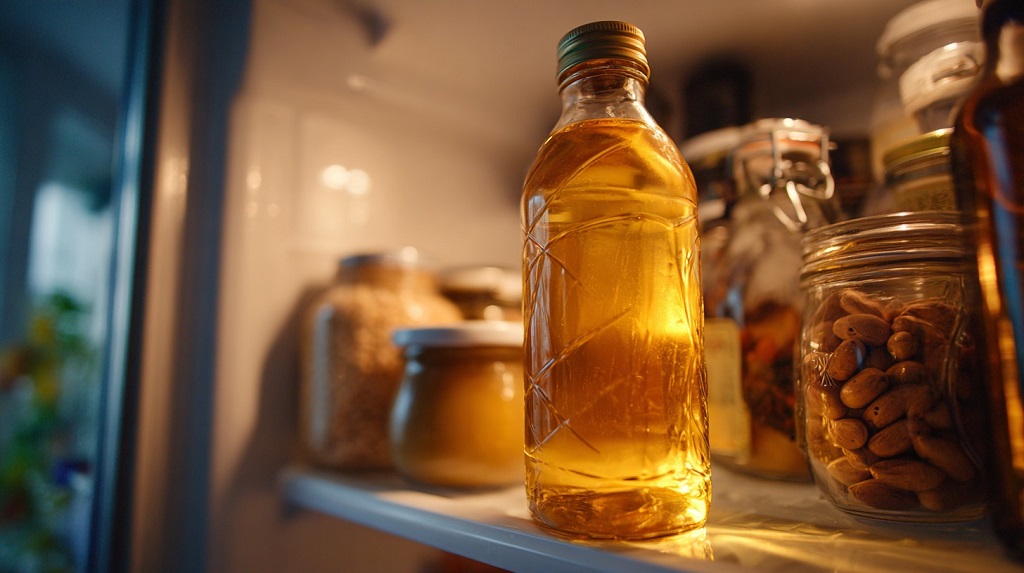Peanut oil is popular in cooking because it can handle high heat without burning and has a light, neutral taste. That makes it a dependable option for frying or quick sautéing.
Still, like any kitchen staple, it doesn’t last forever. Knowing how long peanut oil stays fresh and how to store it correctly helps you avoid waste and keeps your dishes tasting as they should.
In this guide, we’ll cover the shelf life of unopened and opened bottles, the signs that oil has spoiled, and the best storage practices so you can make the most of it.
How Storage Affects Peanut Oil Shelf Life
The shelf life of peanut oil depends on whether the bottle is opened or sealed, and on how you store it.
Unopened Peanut Oil

A sealed bottle of peanut oil usually stays fresh for 1 to 2 years. Because it’s refined, it resists spoilage better than some other oils.
To keep it in good condition, store it in a cool, dark place like a pantry or cupboard. If you refrigerate it, the oil may last even longer without losing quality.
Opened Peanut Oil

Once opened, peanut oil keeps its best flavor and freshness for about six months. After that, the quality starts to decline more quickly.
To slow this process down, store the bottle tightly closed in a dark cupboard or in the fridge. Watch for warning signs like a sour or rancid smell or a darker color – these mean it’s time to discard the oil.
Shelf Life Summary
| Storage Method | Unopened Shelf Life | Opened Shelf Life |
|---|---|---|
| Pantry (cool, dark place) | 1-2 years | ~6 months |
| Refrigerator | 1-2+ years | ~6 months, sometimes longer |
| Freezer | Up to 2 years | Around 6 months (rarely needed) |
Most people will find that keeping peanut oil in the pantry is enough, but refrigeration can give you extra peace of mind, especially once the bottle is opened.
Freezing is rarely necessary, but it won’t harm the oil if you want to store it long term.
Peanut Oil Shelf Life
In simple terms, peanut oil can last up to two years unopened and about six months once opened, depending on storage.
Keeping it in a cool, dark place or in the refrigerator helps preserve freshness.
Beyond these time frames, the best way to judge its quality is by checking for spoilage signs, which we’ll cover next.
How to Tell If Peanut Oil Has Gone Bad

The easiest way to check peanut oil is by smell. Fresh oil has a light, neutral aroma, while spoiled oil develops a sour or rancid odor.
Taste is another clue – if the oil turns bitter or has an off-flavor, it’s no longer good to use. You can also look at the color: peanut oil should be clear and golden.
If it appears darker than usual, that’s a sign it has started to break down and should be replaced.
Tips for Keeping Peanut Oil Fresh
@thecajunninja How to save cooking oil after a fry. 👊🏻 #cookingtips #from #thecajunninja #saving #cookingoil #after #frying #foods ♬ original sound – thecajunninja
Store unopened bottles in a cool, dark place. A pantry or cupboard away from heat is ideal.
- Refrigerate after opening: This slows down oxidation and helps the oil stay fresh for around six months.
- Keep it tightly sealed: Exposure to air and light speeds up spoilage.
- Don’t reuse oil for too long: After frying, discard any leftover oil within about two weeks to keep food safe and flavorful.
Read Also: Why Everyone’s Drinking Bone Broth
Conclusion
Peanut oil can last a long time if stored correctly – up to two years unopened and about six months once opened. The key is simple: keep it sealed, away from heat and light, and use the fridge if you want extra freshness.
Always check for changes in smell, taste, or color, since these are the clearest signs that the oil has gone bad.
By following these straightforward steps, you’ll reduce waste and make sure the oil you cook with adds good flavor, not unwanted off-notes.

